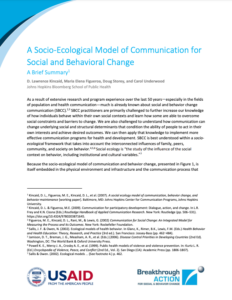The socio-ecological model of communication takes a systems approach to analysis rather than a reductionist approach, meaning that it describes the complexity, interrelatedness, and wholeness of the components of a complex adaptive system rather than just one particular component in isolation from the system in which it is embedded. The two key system features of the socio-ecological model of communication and behavior change are the assumption of embeddedness, a state in which one system is nested in a hierarchy of other systems at different levels of analysis, and emergence, in which the system at each level is “greater than the sum of its parts.”
A Socio-Ecological Model of Communication for Social and Behavioral Change
You are here: Home1 / Resource Library2 / A Socio-Ecological Model of Communication for Social and Behavioral Ch...
This website was originally developed by Breakthrough ACTION (USAID Cooperative Agreement #AID-OAA-A-17-00017) under the leadership of Johns Hopkins Center for Communication Programs. This website is now maintained by Johns Hopkins Center for Communication Programs and its contents are the sole responsibility of CCP. The contents of this website do not necessarily reflect the views of USAID, the United States Government, or Johns Hopkins University.
© Johns Hopkins University. All rights reserved.


